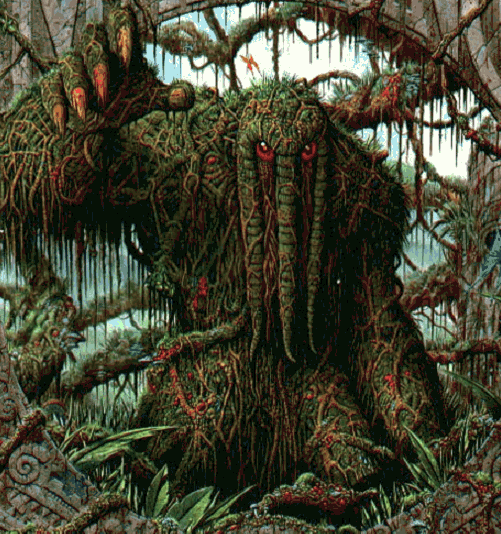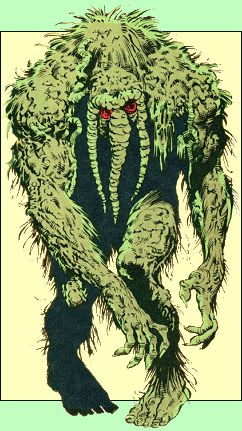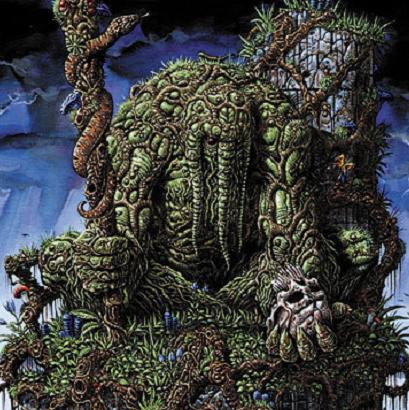Cannaboids (D20 Modern Race)
|
Cannaboid
It should be noted that Cannaboids are intended for use with the d20 Apocalypse variation of d20 Modern, although with little adaptation they will fit any d20 Campaign.
As the use of gene splicing and augmentation became more and more common, it didn’t take long before college students decided to use it for one of their favorite pastimes...”getting high”.
At some point groups of would be botanists began enhancing various strains of Marijuana, first to increase it’s potency and resilience, then to see if they could make it more self reliant.
In order to attain this self reliance they began experimenting with hybridizing the plants with various animal DNA. After multiple failures they found that Human DNA worked the best, and within a few generations they had the beginnings of the sentient plant they were looking for.
Shortly after this success the Final Wars befell the World, and the plants were left to fend for themselves. Now as generations have passed the plants have evolved into the humanoid form of the Cannaboid. With this evolution they have also gained higher intelligence and formed a society for themselves. A society based on a seclusive contemplative life with little use for technology or the things of the past.
Adult Cannaboids stand between 8 to 15 feet tall, depending on age, often weighing between 300 and 500 pounds. Physically they resemble hulking humanoid forms comprised of plant matter similar to that of highly compressed Marijuana “Buds”. Their eyes are large reddish-black spheres that have no lids of any sort. As well Cannaboids have no mouth or nose whatsoever. Although they may appear to have the latter because of a huge vine-like growth that bisects their faces. They also lack conventual ears of any type. Oddly enough they very closely resemble the comic book Super-Hero, “Man-Thing”, from the late 20th Century. Cannaboids are able to communicate with each other, and other biological sentients, by using a form of natural Telepathy.
Most Cannaboids also have various colorful striations throughout their bodies. These stria range from bright green to yellow, red, or purple.
Cannaboids feed like any other plant, drawing water and nutrients from the soil while converting sunlight into energy, and they have a keen natural ability to find the richest soil with the best growing conditions. Although they can be fully active in the night, most Cannaboids prefer to root into the ground and remain motionless in the evenings. Some will even spend this downtime floating in shallow pools of muck filled water. Many will remain rooted or floating for days on end, contemplating the nature of the universe. Others will wander the immediate area examining things and pondering them for hours on end. During their various “contemplations” they will very often commune with one another about their musings with their Telepathic abilities.
Once per year any Cannaboid can allow themselves to be germinated. That is all sentient and non-sentient Cannaboid plants begin releasing pollen, and during that time they can choose to reproduce by cross pollinating with another Cannaboid (sentient or not). If they accept germination they produce 1 to 4 large seed pods. These pods look like golf ball sized greenish-black spheres. Each seed has a 25% chance of growing into a fully mobile and sentient Cannaboid. The others become non-sentient bush-like plants that form into thick heaping pillar shapes. These non-sentient Cannaboids are tended and looked after by the other Cannaboids, and are treated as full members of their enclave. During the reproductive cycle each non-sentient Cannaboid, in the surrounding area, has a 50% chance of becoming germinated. Non-sentient Cannaboids, that become germinated, will produce 1 or 2 seed pods. Each of these has a 25% chance of growing into a fully sentient Cannaboid. Sentient Cannaboids remain non-sentient and immobile for the first 2 years of their lives. At that time they have reached a height of about 4 to 6 feet tall, and are able to begin moving about. These young Cannaboids have some of the basic memories and knowledge of it’s parents. They quickly learn more of the world around them as they begin communicating with the rest of the enclave. Cannaboids are asexual, having neither male nor female divisions.
Sentient Cannaboids live for approximately 150 years, while non-sentient Cannaboids live for about 75 years. Sentient Cannaboids are able to reproduce starting from the age of 2 years until they are about 70 years of age. Non-sentient Cannaboids begin reproducing at around 2 years of age and continue to do so throughout their entire lives. When a sentient Cannaboid “dies” it roots itself into the earth and becomes very much like a standard non-sentient Cannaboid. Most will continue to exist in this form for another 50 years or so before slowly withering and decaying into the ground beneath it. Non-sentient Cannaboids begin withing as soon as they die, rotting into the ground within a few years.
While Cannaboids can see perfectly well in both dark and light with their unique eye structures, and they are able to sense sound vibrations from the world around them through the complex nerve structure that embeds their bodies, they can have problems dealing with other non-Cannaboid beings. As they rely upon Telepathy as their main form of communication, spoken words have little meaning to them, any creature attempting to convey something to a Cannaboid by speech alone will find that only the most simple of ideas can be expressed to them. Even then it often takes exaggerated physical mimicry of the idea (ie. pretending to eat from a plate to show the concept of food) in order to drive the point home. Unfortunately many species do not like (or are frightened of) Telepathic communication. Therefore if a Cannaboid initiates contact with them they react negatively. While they have problems with the spoken word Cannaboids are fully capable of associating particular sounds with certain events (ie. gunshots, thunder, vehicles, etc.).
Most Cannaboids prefer to spend their time in solitude admiring nature, thinking about how any particular thing relates and interacts with the world around it. And sometimes this may involve other sentient creatures or possibly technological creations. Often those instances will result in the Cannaboid interacting with a non-Cannaboid. The outcome always varies, depending upon how the encountered species reacts to the Cannaboid. By nature Cannaboids express a curiosity about the world around them and have no concept of privacy or personal space. Unless threatened they remain peaceful and only have a desire to watch as others go about their tasks. If attacked they will defend themselves by any means they can. They will also always go to the aid of any Cannaboid member of their enclave that is threatened or harmed.
Tools and machines are the things that puzzle Cannaboids more then anything else. They do not see the need to reshape and change natural things into something else for a being’s use. But they find others who do amusing to observe.
Campaigning
The initial Cannaboid enclave should start out either in the dense woods of the New Northwest, or the swampy remains of the New Southeast. Still Cannaboids can be found within a few miles of any ancient College or other facility that may have once worked with plants.
Cannaboids live in small enclaves, doing their best to avoid outside contact. Even though their curiosity often gets the best of them. Most Cannaboids would rather remain within their enclave’s region, but every so often a Cannaboid gets a wanderlust and travels the world looking to see what lies beyond the confines of his enclave’s region.
As well, once an enclave reaches a certain size some Cannaboids will be sent out from the enclave in order to find other suitable locations for new enclaves that the group can establish. The Cannaboids hope that by keeping the size of their enclaves down to a minimum they can help protect their solitary lifestyle.
Player Character Cannaboids are one of these two types of Cannaboids. Player Cannaboids can be either Strong or Tough Heroes, and must choose the Hunter or Athlete Occupation.
Species Traits
Poisonous Body: Due to the strong emphasis placed on increasing the potency of the Marijuana plants that evolved into the Cannaboids, all members of the species (both Sentient and Non-sentient) contain a highly dense concentration of a mind numbing toxin similar to THC. If a Cannaboid is burned or set on fire the toxin will be released in a thick smokey cloud, affecting everyone who breathes the smoke within a 6 foot radius. The toxin requires a Fortitude save against DC 15, and does 1d2 points of Wisdom damage and 1 point of Dexterity damage initially, as well a victim loses 1 point of Wisdom and 1 point of Dexterity as secondary damage. Victims continue to suffer secondary damage each round they spend within the smoke, if either Dexterity or Wisdom reach 0 the victim falls unconscious for 1d3 hours. Although if still exposed to the smoke will continue to take secondary damage to the remaining stat, automatically failing their saving throw each round, if the remaining stat reaches 0 as well the victim dies. The toxic smoke is only produced while the Cannaboid is aflame, it ceases as soon as the Cannaboid stops taking fire related damage. The toxin creates a physically numb feeling accompanied by a sense of euphoria, both effects obviously increase the longer someone is exposed to the toxin. Lost ability points return at the rate of 1 point to each stat per hour.
Ingesting any piece of a Cannaboid requires a Fortitude save against DC 17, and does 1d6 points of Wisdom damage and 1d6 points of Dexterity damage initially (a successful save allows the victim to take half damage, with a minimum of 1 point). The victim takes 1d2 points of Wisdom damage and 1d2 points of Dexterity damage as secondary damage for the next 3 rounds. The same conditions concerning unconsciousness and lethality, as stated for the inhaled effects, apply to ingesting it as well. Lost ability points return as stated for the inhaled effect as well.
Poisonous Claws: Sentient Cannaboids grow long bone-like “fingernails”, these thick claws can cause not only physical damage but can deliver a dose of poison from the Cannaboid’s body into the bloodstream of the victim. A successful hit from a Cannaboid causes 1d6 (plus Strength modifier) points of damage. The first 3 attacks are accompanied by a dose of poison, this requires a Fortitude save against DC 15, and does 1d2 points of Dexterity damage initially, and 1d2 points of damage to Dexterity as secondary damage. After those first 3 attacks it then takes 4 hours of rest to refill the “nail glands” with enough toxin to be effective as a weapon again
Psionic: All Cannaboids possess the Psychic Aptitude mutation, and as detailed below, all possess Telepathy as a natural talent. It should also be noted that as Cannaboids are naturally Psionic they do not need to make a power activation roll, when using any Telepathy power, although they must still spend 1 round “powering up”. As well Cannaboids never suffer the effects of Feedback when using any Psionic power (except when attempting to learn a new power, then all effects apply).
Telepathy: Sentient Cannaboids have developed a very powerful form of natural telepathy, that they use for communication. Cannaboid telepathy follows most of the same rules that are described on page 132 of the Gamma World Player’s Handbook, with a few exceptions: The ranged attack roll gains a +3 bonus in addition to any Wisdom modifier being applied, and the contact allows two-way communication when established, although this is done more through the use of images, scents, feelings, memories, or other sensory impressions then through the use of words. Cannaboids do not need to make a ranged attack roll to contact another Cannaboid (unless it is actively resisting), and do not gain any bonuses toward their power increase roll when using their telepathy to contact other Cannaboids. Lastly Cannaboids only receive the power increase roll bonus the first time they contact any one particular non-Cannaboid sentient with any Telepathy power. All additional contacts with that person do not grant the bonus. Cannaboids may only contact 1 non-Cannaboid mind at a time, but Cannaboids may contact multiple Cannaboid minds at one time. A Cannaboid can contact as many Cannaboid minds at one time, equal to it's Intelligence.
Speechless: As Cannaboids do not have any vocal cords they are unable to utter any sounds whatsoever. As a result they have no spoken language, and cannot take any class or use any feat or skill that requires verbalization.
Monstrous: Sentient Cannaboids are large hulking creatures (all Cannaboids are considered Large opponents), gaining a +2 bonus to both their Strength and Constitution, and receiving a +2 bonus to all Fortitude saving throws. Also all Cannaboid suffer a -3 penalty to their Intelligence, Dexterity, and Charisma stats. The large clawed, and slightly disproportionate hands of the Cannaboid causes them to receive a -4 penalty on all actions that concern using a tool or weapon that has been designed for normal humanoid hands. Due to their unique and resilient body structures Cannaboids gain 5 bonus Hit Points upon creation, and get a +3 bonus to their Defense. Unfortunately this thick plant-like body may burn if exposed to fire (or fire-like heat) based attacks, if such an attack occurs standard rules for catching on fire apply (page 213, D20 Modern Core Rulebook).
Low-Light Vision: All Cannaboids possess Low-Light Vision.
Mutant Heritage: Due to their genetically engineered history Cannaboids have the same penalty to Feats and Skills that other Mutants suffer (see page 30 in the Gamma World Player’s Handbook). As well, because Cannaboids are a fusion of Human and plant DNA, Cannaboids are susceptible to all the same poisons (except for the Cannaboid toxin) and diseases that effect pure animals. The only exception being substances that are inhaled, as Cannaboids do not breathe as animals do, in these cases they gain a +2 to saves versus their effects. Also they cannot suffocate, drown, or be strangled. Cannaboids are also susceptible to agents that effect plants, gaining no additional protection against them. Because Cannaboids possess over 98% plant DNA they cannot use bioware, which is designed to work in conjunction with human DNA. Any attempt by a Cannaboid to use bioware fails, as does any attempt to implant a biotech device into a Cannaboid character.
Healing and Plant Immunities: Cannaboids heal normally, getting rest by rooting themselves into the soil and remaining inactive for 8 hours. Cannaboids feed and absorb water at this time as well, this along with sunlight is all the food they need. If a Cannaboid goes for an extended period of time without sunlight, or because they cannot root (ie. contaminated earth, artificial ground, etc.), they suffer the standard effects of starvation. While rooted and healing Cannaboids can recover from any type of wound (bullets, fire, acid, etc.), and even regenerate lost limbs (including the head). Cannaboids are immune to sleep, paralysis, or stunning effects. They are not subject to critical hits or the effects of massive damage.
Bonus Skills: Spot +3, Swim +3, Listen +3, Knowledge (Botany) +5
Bonus Feats: None
Back to Main Page → D20 Modern → Races


